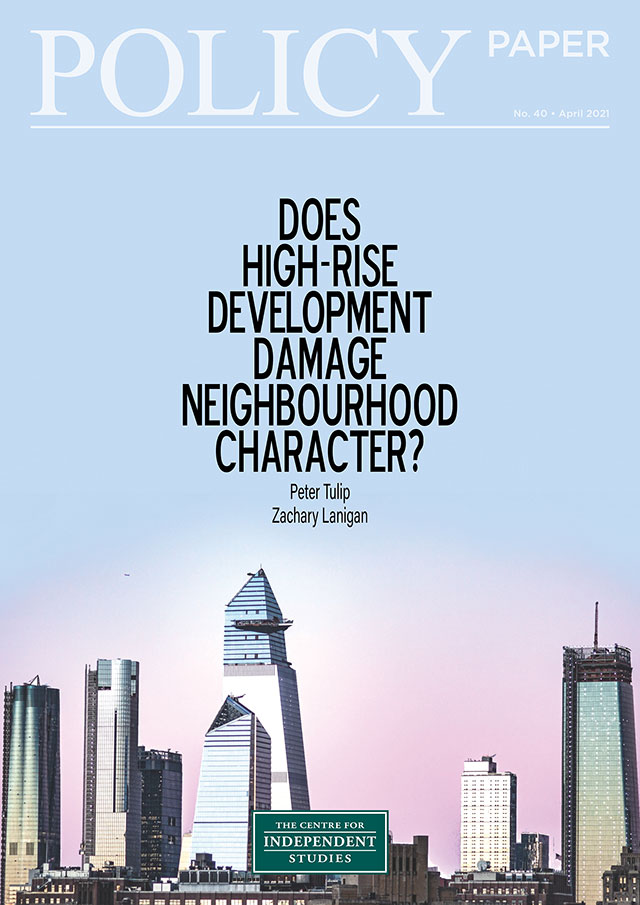
Local residents often oppose new high-rise development apartment buildings on the grounds that they would harm neighbourhood character. This paper suggests these concerns are overstated.
The paper examines several examples of high-rise development in Sydney: Chatswood, Forest Lodge, Green Square, Liverpool and Turrella. If these developments harmed neighbourhood character, as local residents often claim, nearby house prices should fall. But that does not happen. Instead, house prices in each suburb closely track the prices of houses in adjoining suburbs – both before and after the development.
This implies that high-rise development apartments have little effect on neighbourhood amenity. A secondary implication is that houses in adjacent suburbs are very close substitutes. projects
These results have policy implications. Many zoning regulations restrict the supply of new apartments, raising the cost of housing. The paper suggests that these regulations are hard to justify in terms of preserving local amenity. Zoning regulations appear to increase the cost of housing unnecessarily.
High-rise development doesn’t harm neighbourhood character
Fears of many local residents that tall apartment buildings would harm neighbourhood character are overstated, according to new research from the Centre for Independent Studies.
In Does high-rise development damage neighbourhood character?, authors Peter Tulip and Zachary Lanigan examine several examples of high-rise development, including Chatswood, Harold Park and Green Square. If developments like these harmed neighbourhood character, as local residents often claim, nearby house prices should fall. But that does not happen.
The chart below shows median house prices in Chatswood and adjoining suburbs. From 2013 to 2015 (shaded) six very tall apartment towers were constructed near Chatswood station, making the suburb a symbol of overdevelopment. However, house prices in Chatswood closely tracked prices in adjoining suburbs, both before and after the towers were constructed.
The authors argue that, judging by willingness to pay, the relative amenity of living in Chatswood barely changed. The authors conduct similar analyses for other suburbs that have experienced high-rise development and find much the same result: house prices near new apartment buildings move by about the same as house prices elsewhere.
According to the authors, these results do not mean that residents are necessarily wrong to oppose new developments – they are entitled to their preferences. However, other potential residents have different preferences: they like the access to shops and transport that comes with high density. Many potential residents want a walkable lively neighbourhood and will pay more for that. Dr Tulip and Mr Lanigan suggest that these competing preferences appear to approximately cancel out.
The authors note these results have important policy implications. Many zoning regulations restrict the supply of new apartments, raising the cost of housing. Dr Tulip and Mr Lanigan argue that these regulations are hard to justify in terms of preserving local amenity. Zoning regulations appear to be increasing the cost of housing unnecessarily.
Also by Dr Peter Tulip: Planning restrictions harm housing affordability
SELECTED REFERENCES
Ahlfeldt Gabriel M and E Pietrostefani. 2019. “The Economic Effects of Density: A Synthesis”, Journal of Urban Economics, 111, pp 93–107.
Asquith, Brian J., Evan Mast, and Davin Reed. 2019. “Supply Shock Versus Demand Shock: The Local Effects of New Housing in Low-Income Areas.” Upjohn Institute Working Paper 19-316. Kalamazoo, MI: W.E. Upjohn Institute for Employment Research.
Australian Property Monitors (APM); https://www.apm.com.au/ APM is part of the Domain Group.
Brunes, Fredrick, Cecilia Hermansson, Han-Suck Song and Mats Wilhelmsson. 2020. “NIMBYs for the rich and YIMBYs for the poor: analyzing the property price
effects of infill development” Journal of European Real Estate Research Vol. 13 No. 1, 2020 pp. 55-81.
Damiano, Anthony and Chris Frenier “Build Baby Build?: Housing Submarkets and the Effects of New Construction on Existing Rents” https://www.tonydamiano.com/project/new-con/bbb-wp.pdf.
Demographia International Housing Affordability. 2021. Urban Reform Institute and the Frontier Centre for Public Policy. http://www.demographia.com/dhi.pdf.
Photo by Aleksandr Rogozin on Unsplash
